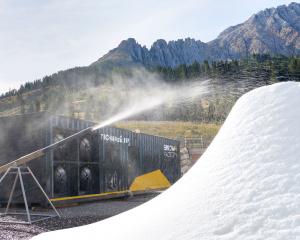Recent 1080 aerial drops near Queenstown and Wanaka have ''substantially'' reduced pest numbers and boosted native bird populations, Department of Conservation staff say.
Doc completed its aerial 1080 pest control operations over nearly 20,000ha in the Dart, Routeburn and Caples valleys in August last year and just over 7000ha in the Matukituki Valley in December.
A 1080 drop in the Makarora area was postponed but could take place this year.
Doc's nationwide ''Battle for our Birds'' campaign has resulted in more than 600,000ha of conservation areas being treated during the past eight months, using aerial 1080 drops to control rodents, possums and stoats.
In the Dart and Routeburn valleys, close to 100% of mohua nests monitored during January produced chicks and 97% of adults survived.
All key mohua populations received pest control last year so there were no non-treated areas monitored.
However, in 2006, nesting success without pest control in the Dart was just 47%.
Rat tracking percentages were drastically reduced in the Caples and Dart-Routeburn valleys from 26% to 6% and 20% to 0%, respectively.
Queenstown Doc conservation services manager John Roberts said ongoing stoat trapping, combined with the drop, had also enabled six whio (blue ducks) to be reintroduced to the Rock Burn Valley, near the Routeburn Track.
Figures provided by the Central Otago Doc office show a drop in mice tracking percentages in the East Matukituki area from 71% at the start of December, to 8% in January, following the 1080 drop.
In the West Matukituki, figures dropped from 91% to 22%.
Stoat tracking rates in January for both the east and west Matukituki valleys were zero.
Office spokeswoman Annette Grieve said Doc also had tracking tunnel lines in the Wilkin, Siberia and Hunter valleys and near Haast Pass which had not been treated with 1080 and in monitoring carried out in January stoats were tracked on 30% of those lines.
''So we can reasonably say that the 1080 substantially reduced the number of stoats in the East and West Matukituki, with ongoing trapping in the west Matukituki contributing to this result.''
The Matukituki operation was primarily conducted for the control of possums, but those monitoring results were not yet available.
Murihiku biodiversity ranger Finlay Cox said the 1080 drop in the Catlins in late November had reduced rat tracking percentages from 10% to undetectable levels, while mice tracking had dropped from 79% to undetectable levels.











